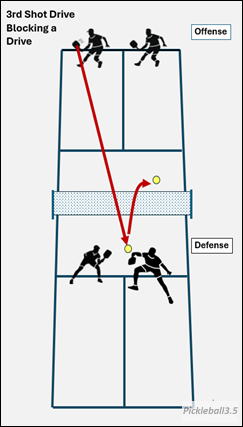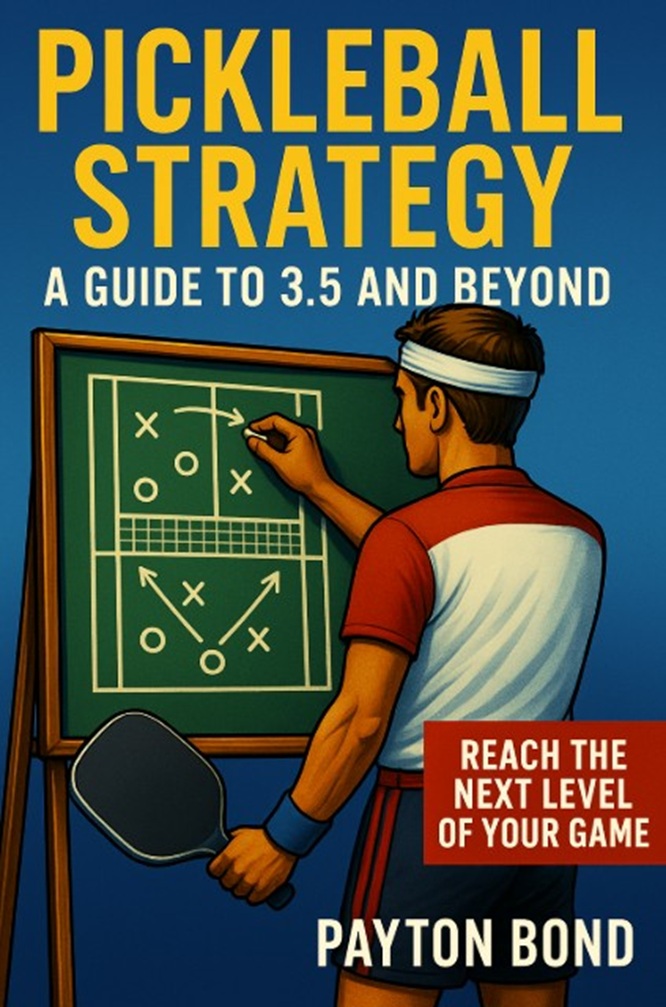
Blocking a Pickleball Drive
Blocking a pickleball drive is as straightforward as it sounds—no fancy swings or heroics needed. Simply hold your paddle steady, and let the ball’s momentum do the work.
Why Players Drive Third Shots
Some players drive most of their third shots either because they haven’t mastered the drop shot or because they’re power players who love to hit hard. Their strategy? Force you to make a mistake. They’re hoping for one of two outcomes:
- You totally whiff the ball.
- You pop it up, giving them an easy opportunity to attack.
Turning Drives Into Opportunities
Drives hit from deep in the court naturally lose some speed as they approach the net, making them easier to handle. When you’re on the receiving end of a deep, hard drive, consider it an opportunity:
- If it’s slow and high, smash it back with confidence.
- If it’s mid-height and attackable, use a punch volley to send it back with pace, keeping them pinned at the baseline.
The Soft Block
Another effective option is the soft block. Instead of returning the ball aggressively, gently block the drive over the net with a controlled paddle. If executed well, your opponent deep in the court will watch the ball drop softly over the net, well out of their reach.
By mastering the art of blocking, you can turn your opponent’s hard drives into opportunities to control the rally. Whether you choose to smash, volley, or block softly, staying calm and composed is the key to handling power players with ease.
Blocking a Pickleball Drive
In the illustration below, a fast drive is hit on the third shot from deep in the court, the defensive player softly blocks the shot just over the net.

Blocking a pickleball drive shot requires finesse and a soft touch at the net.
It’s a challenging skill that demands practice, as the margin for error is small. Hit it too softly, and the ball will drop into the net; hit it too hard, and you risk popping it up, giving your opponent an easy opportunity to attack.
Use this technique when you’re at the kitchen line, and the drive shot is coming from deep in the court. A well-executed block can keep your opponent at bay, as they’ll struggle to advance to the net to respond.
However, be cautious of drives with heavy topspin that dip just over the net—these shots may be too low for an effective block and require a quick, alternative response.
The Soft Block: A Kitchen Delivery with Style
A soft block is like hand-delivering the ball right into your opponent’s kitchen—no RSVP required. To pull it off, simply position your paddle in the path of the drive shot and let the ball do the work. With a gentle grip and soft contact, the drive’s speed rebounds off your paddle, sending the ball gracefully into their kitchen.
The secret? A light touch. A rigid grip will send the block back to far or pop it up. Master this technique, and your blocks will fall just beyond the net, leaving your opponents just standing and watching the point end.
Other Considerations
- Best for Drives: While the soft block can defend against almost any shot, it’s most effective against fast-moving drives.
- Drives arrive before the offensive player can move forward, making it tougher for them to reach your block.
- For drop shots, it’s better to volley back to their feet to keep them from advancing since drop shots float more slowly, giving the offense time to close in.
- Beware the Shake and Bake: Aggressive teams using the Shake and Bake may counter your block with one partner rushing the net while the other drives. If you’re facing these quick movers, they will sprint in towards the net as soon as they hit the drive and will likely get to the blocked shot.
Summary
Once you master the soft block and use it effectively, your opponents will rethink their strategy for driving deep balls at you.
Check out Payton Bonds new eBook!
Pickleball Strategy – A Guide to 3.5 and Beyond
See it on Amazon.

👤 Follow Payton Bond
All Star and Top Contributor on multiple Facebook Pickleball Forums.
Contributor at TheKitchenPickle.com.
Visit Payton Bonds Facebook Page
Keep Learning
Read the next post in the Third Shot series.
Mastering the Third Shot Drop: Your Key to 3.5+ Play

